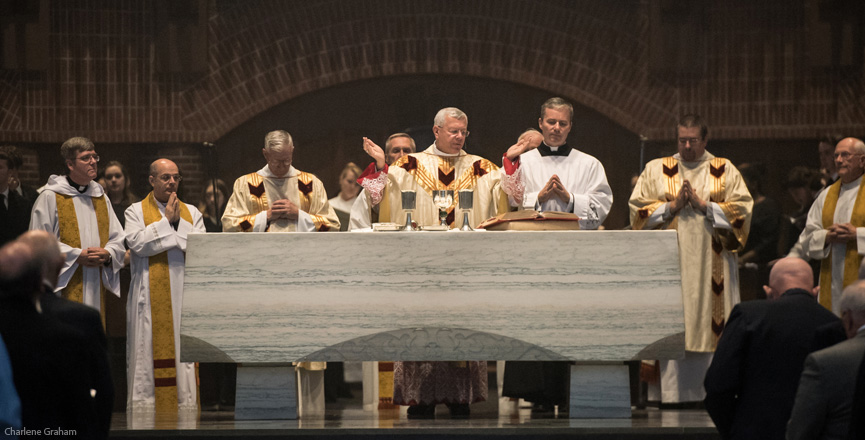
Home » Worship/Sacraments » Our Faith » Worship » Order of the Mass
Order of the Mass
What is the “Mass”?
The Mass, or celebration of the Eucharist, is the principal liturgical action in the Roman Catholic Church. The word “Mass” comes from the Latin word, missa meaning “mission” or “sending” because the liturgy is to send forth the faithful to bring forth the Good News of Jesus and to be His sacramental presence in the world.
The Mass was established by the Lord Jesus at the Last Supper on the night before He died for us. In this celebration, we participate in the mystery of salvation by remembering the sacrificial death and resurrection of the Lord.
The Liturgy of the Word and the Liturgy of the Eucharist
There are two major parts of the Mass: the Liturgy of the Word and the Liturgy of the Eucharist.
The Liturgy of the Word is the first major component of the Mass during which selections from the Scriptures are proclaimed. A teaching, known as the “homily” is given using the Scriptures of the day to explain the Christian life to the faithful. On Sundays and major feasts of the Church, the faithful profess their faith using the formula known as the “Nicene Creed.” In certain instances, the Apostles’ Creed may be used in its place. The Liturgy of the Word concludes with the Prayer of the Faithful during which the people exercise their royal priesthood by interceding for the needs of the whole world.
The Liturgy of the Eucharist forms the second major part of the Mass. It begins with several minor preparatory rites and culminates with the Eucharistic Prayer. During this prayer, the priest invokes the action of the Holy Spirit (epiclesis) to change the bread and wine into the Body and Blood of Christ. After several more minor rites, members of the assembly who are Roman Catholic and not in the state of serious sin, are invited to receive the Body and Blood of the Lord.

Structure of the Mass
Introductory Rites
Introit or Processional Hymn
Veneration of the Altar
Sign of the Cross
Greeting
Penitential Rite
Glory to God (on all Sundays except during Advent and Lent; on solemnities and major feast days during the week)
Collect or Opening Prayer
Liturgy of the Word
First Reading (on Sundays and solemnities, generally from the Old Testament; during the Easter Season, from the Acts of the Apostles; on feasts of the Blessed Virgin Mary, may be from the Book of Revelation)
Responsorial Psalm (taken from one of the 150 Psalms or from an Old or New Testament Canticle)
Second Reading (only on Sundays, solemnities and special feast days; always from the epistles)
Gospel Acclamation (outside of Lent, the Alleluia is sung. During Lent, another approved acclamation is sung. If the Gospel Acclamation is not sung, it should be omitted.)
Gospel (taken from one of the four Gospels)
Homily
Profession of Faith (recited or sung on all Sundays and solemnities)
General Intercessions or Prayer of the Faithful
Liturgy of the Eurcharist
Preparation of the Altar and Presentation of the Gifts
Invitation to Prayer
Prayer over the Gifts
Preface Dialogue
Preface and Acclamation
Eucharistic Prayer
Concluding Doxology
The Lord’s Prayer
Rite of Peace
Breaking of the Bread
Invitation to the Eucharist
Distribution of Holy Communion
Sacred Silence
Prayer after Communion
Concluding Rites
Announcements (if there are any)
Final Blessing and Dismissal
Read more information on the Order of the Mass
